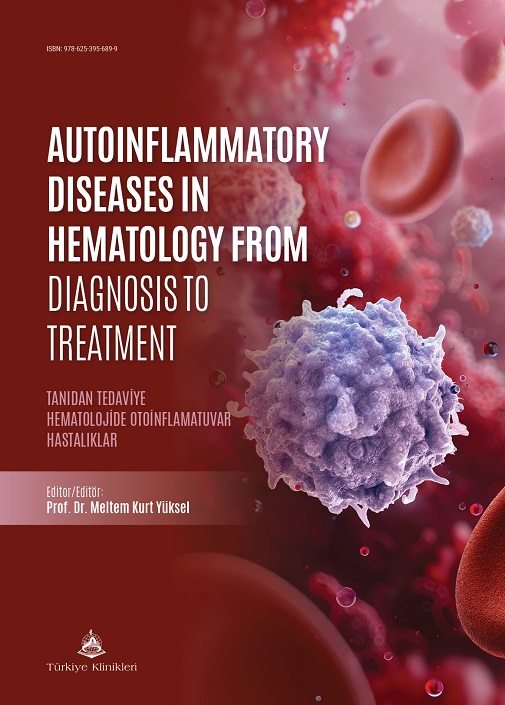Classification of diseases has an essential place in health sciences. In recent years, rapidly increasing genetic diagnostic methods have shed light on the mechanisms of diseases, but have made classifications more complex. In the field of hematology, two different classification systems were published in 2022, one by the World Health Organization (WHO) and the other by the International Consensus Classification (ICC). These classifications aim to cover all clinical, morphological, pathological, and genetic changes associated with hematologic diseases. However, autoinflammatory hematologic diseases, which have increased rapidly in recent years, are not yet included in these classifications.
Autoinflammatory hematologic diseases are clonal, inflammatory, chronic disorders involving multiple disciplines. Unlike autoimmunity, autoinflammation is a disease of the innate immune system. Autoinflammation was first demonstrated in Familial Mediterranean Fever (FMF), which affects many organs simultaneously, and its genetic basis was identified years later. The first inflammatory hematologic disorder, VEXAS (V, Vacuole; E, E1 ubiquitin activating enzyme; X, X-linked; A, Autoinflammation; S, Somatic Mutation), was identified in 2020 with a multidisciplinary approach thanks to careful observation and data recording. Thanks to this discovery, which has changed what we know, it has been shown that hematologic diseases, in their clonal features, can exhibit autoinflammatory features, immune dysregulation can trigger inflammation, and uncontrolled inflammation can result in systemic or local tissue damage. Furthermore, studies have shown that aging is vital in the development of clonal hematopoiesis and inflammation, as well as environmental factors. This book aims to classify autoinflammatory hematologic diseases and present in detail the diagnostic and therapeutic modalities of the diseases identified to date.
This study describes the history, clinical findings, and current treatments of inflammatory hematologic diseases classified according to etiopathogenesis, which have not yet been included in the classical classifications and may change.
Thanks to VEXAS syndrome, the prototype of this disease group, it has been demonstrated that a genetic abnormality can be identified as the initiator of every disease. It has become clear that existing genetic abnormalities can affect multiple systems and that interdisciplinary collaboration between Rheumatology, Pathology, and Genetics is essential for accurate diagnosis.
In the future, artificial intelligence can shorten the diagnostic process for such diseases. Bioinformatics methods will play a critical role in identifying the initiating abnormalities of diseases by enabling the discovery of deeper molecular details. However, despite technological advances, it is still impossible for artificial intelligence to replace the human mind, observe and feel like a human, and create a patient-physician dialog. Autoinflammatory hematologic diseases confirm the understanding that ‘there is not a disease, there is a patient’ and reveal the necessity of a multidisciplinary approach and the unique evaluation of each individual.
Prof. Dr. Meltem KURT YÜKSEL
Ankara University, Faculty of Medicine, Department of Hematology and Stem Cell Transplant Unit,
Ankara, Türkiye
Bölümler
SECTION 1
Basics in Inflammatory Diseases
01 | Physiology of Inflammation
Aslı KUM
02 | Dysregulation of Inflammation-Autoinflammation-MGCS
Hülya YILMAZ TEKİNHATUN
03 | Classification of Inflammatory Hematological Diseases (IHD)
Sinan MERSİN
SECTION 2
Monogeneic Inflammatory Disorders
Section Editor/Bölüm Editörü: Nüket KUTLAY
04 | VEXAS Syndrome
Meral ULUKÖYLÜ MENGÜÇ
05 | GATA-2 Deficiency
Cemaleddin ÖZTÜRK
06 | Deficiency of ADA2 (DADA2)
Gül YAVUZ ERMİŞ
SECTION 3
Cytokine Storm Syndromes
Section Editor/Bölüm Editörü: Gülşah KAYGUSUZ
07 | Hemophagocytic Lenfohistiyocytosis
Buğra SAĞLAM
08 | Castleman Disease
Gülcan KÖKCÜ
SECTION 4
Inflammatory Hematologic Disorders (IHD) Associated with Abnormal Serum Protein Electropheresis (SPEP)
A. IHD with Monoclonal Hypergammaglobulinemia
Section Editor/Bölüm Editörü: Ahmet GÜL
09 | IHD with MGCS
Fadime Nurcan ALHAN
10 | Systemic Capillary Leak Syndrome (Clarkson’s Disease)
Ece VURAL
11 | TEMPI Syndrome
Ünal ATAŞ
12 | Scleromyxedema
Bedrettin ORHAN
13 | Schnitzler’s Syndrome (SCHS)
Fatma AYKAŞ
B. IHD with Polyclonal Hypergammaglobulinemia
Section Editor/Bölüm Editörü: Ahmet GÜL
14 | Rosai Dorfman Destombes Disease
Bülent KARAKAYA
15 | Cutaneous and Systemic Plasmacytosis
Serkan ÜNAL
16 | Hypergammaglobulinemic Purpura of Waldenstrom
Ramazan ERDEM
17 | Angioimmunoblastic T Cell Lymphoma (AITL)
Fatma KEKLİK KARADAĞ
18 | Hyperimmunoglobulin D Syndrome (HIDS)
Sevde YAZICI ŞAHİN
19 | Kikuchi Disease
Taha Ulutan KARS
SECTION 5
Hematopoieitc Stem Cell Transplantation in IHD
Section Editor/Bölüm Editörü: Asu Fergün YILMAZ
20 | Allogeneic Donor Selection
İlknur NİZAM ÖZEN
21 | Allogeneic Stem Cell Transplantation
Tuğrul ELVERDİ



